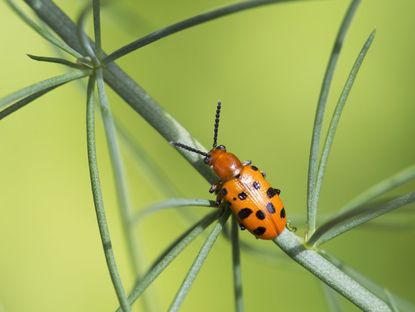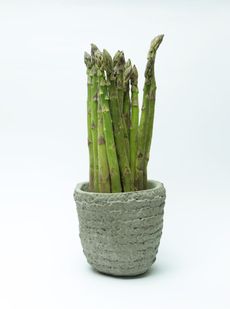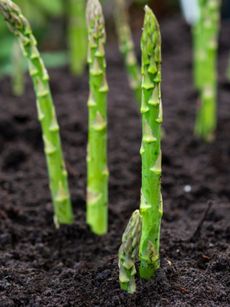Spotted Asparagus Beetle Facts: Controlling Spotted Asparagus Beetles In Gardens


Growing asparagus is a long-term investment. It can take several years to establish an asparagus patch enough to produce a significant edible crop. Once it takes hold, however, it should produce plenty of spears reliably every spring for years and years to come. That’s why it can be especially devastating when an asparagus patch falls victim to pests. One very common asparagus pest is the spotted asparagus beetle. Keep reading to learn some spotted asparagus beetle facts and how to prevent spotted asparagus beetles.
Spotted Asparagus Beetles in Gardens
Asparagus is a favorite food of two very similar bugs: the asparagus beetle and the spotted asparagus beetle. Of the two, the spotted asparagus beetle is much less of a concern, so it’s important to be able to tell them apart. The asparagus beetle is blue or black with six off-white spots on its back. The spotted asparagus beetle, on the other hand, is a rusty orange color with a varying number of black spots on its back. While asparagus beetles can cause some real damage to a crop, having spotted asparagus beetles in gardens is not of much concern because of when its eggs hatch. The spotted asparagus beetle lifecycle is such that the larvae emerge just in time to eat the asparagus berries, long after the asparagus has passed its prime harvesting stage. Unless you’re growing asparagus to collect the seed, this shouldn’t be a problem.
How to Get Rid of Spotted Asparagus Beetles
Although having spotted asparagus beetles in gardens is not really a reason to be concerned, you may still want to get rid of them. Controlling spotted asparagus beetles can be done in a few different ways. One very easy and pretty effective method is hand removal. If you have a small asparagus patch, simply pick off the individual bugs and drop them in a bucket of soapy water. You might have a mix of adult beetles and larvae. Another good and very effective method is planting only male plants-- these won’t form berries and should not attract spotted asparagus beetles.
Gardening tips, videos, info and more delivered right to your inbox!
Sign up for the Gardening Know How newsletter today and receive a free download of our most popular eBook "How to Grow Delicious Tomatoes."

The only child of a horticulturist and an English teacher, Liz Baessler was destined to become a gardening editor. She has been with Gardening Know how since 2015, and a Senior Editor since 2020. She holds a BA in English from Brandeis University and an MA in English from the University of Geneva, Switzerland. After years of gardening in containers and community garden plots, she finally has a backyard of her own, which she is systematically filling with vegetables and flowers.
-
 Urban Composting Guide: How To Compost In The Middle Of The City
Urban Composting Guide: How To Compost In The Middle Of The CityUrban composting does not have to be daunting. You can compost in the city, and maybe even try some urban worm composting!
By Mary Ellen Ellis
-
 Shrub Diseases And Pests To Watch Out For
Shrub Diseases And Pests To Watch Out ForShrub diseases and pests can be challenging. Learn how to recognize and eradicate them before they can present a danger to your plants.
By Susan Albert
-
 What Is White Asparagus – How Does White Asparagus Grow
What Is White Asparagus – How Does White Asparagus GrowHere's a real head-scratcher. There are no varieties of white asparagus! So how does white asparagus grow? Read on to find out.
By Laura Miller
-
 Potted Asparagus Plants – Can You Grow Asparagus In Containers
Potted Asparagus Plants – Can You Grow Asparagus In ContainersThe introduction of new asparagus cultivars has made the process of growing and caring for these plants easier than ever before. But can you grow asparagus in a pot? Click on the following article to learn more about container grown asparagus plants.
By Tonya Barnett
-
 Asparagus Winter Care: Tips On Winterizing Asparagus Beds
Asparagus Winter Care: Tips On Winterizing Asparagus BedsOnce established, asparagus is fairly low maintenance with the exception of keeping the area weed free and watering, but what about overwintering asparagus plants? Do asparagus need winter protection? Find out in this article.
By Amy Grant
-
 What’s The Difference Between Male And Female Asparagus Plants
What’s The Difference Between Male And Female Asparagus PlantsWe all know that some plants have male reproductive organs and some have female and some have both. How about asparagus? Are there really male or female asparagus? If so, what's the difference between male and female asparagus? Find out here.
By Amy Grant
-
 What Is Asparagus Rust: Tips On Treating Rust In Asparagus Plants
What Is Asparagus Rust: Tips On Treating Rust In Asparagus PlantsAsparagus rust disease is a common but extremely destructive plant disease that has affected asparagus crops around the world. Learn more about asparagus rust control and treatment in your garden using information from this article.
By Mary H. Dyer
-
 Rotting Asparagus Plants: Treating Asparagus Crown And Root Rot
Rotting Asparagus Plants: Treating Asparagus Crown And Root RotAsparagus crown and root rot is one of the most economically disastrous diseases of the crop worldwide. Asparagus crown rot is caused by three species of Fusarium. Learn more about controlling asparagus fusarium crown rot and root rot here.
By Amy Grant
-
 Asparagus Companion Plants – What Grows Well With Asparagus
Asparagus Companion Plants – What Grows Well With AsparagusAsparagus plant companions are plants that have a symbiotic relationship, one that is mutually beneficial to each. In the following article, we will discuss the benefits of companion planting with asparagus and what grows well with asparagus.
By Amy Grant
-
 Types Of Asparagus – Learn About Different Varieties Of Asparagus
Types Of Asparagus – Learn About Different Varieties Of AsparagusAsparagus is a long-lived perennial vegetable of many types. You can learn more about different asparagus varieties, including a few heirloom asparagus types, by clicking the article that follows.
By Mary H. Dyer